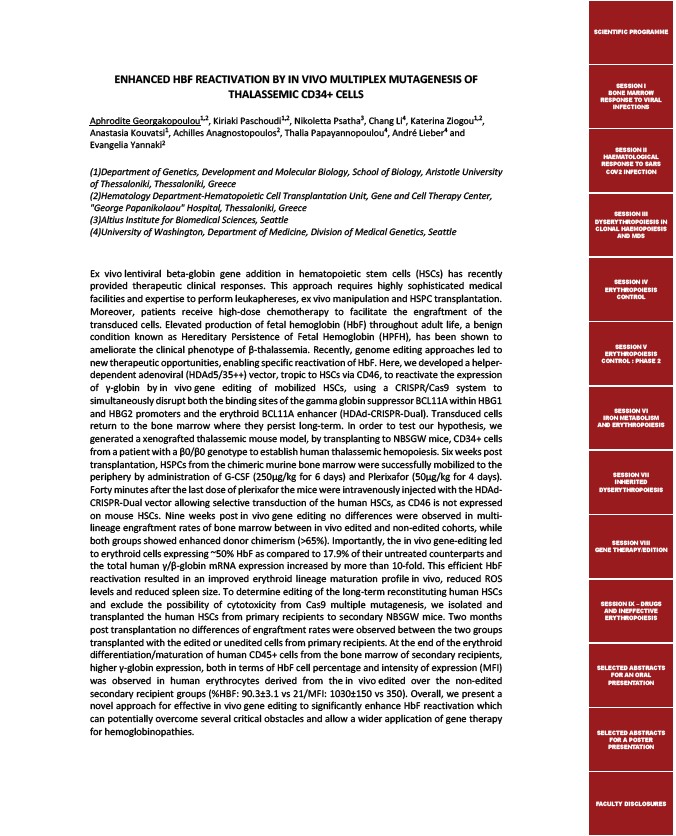
ENHANCED HBF REACTIVATION BY IN VIVO MULTIPLEX MUTAGENESIS OF
THALASSEMIC CD34+ CELLS
Aphrodite Georgakopoulou1,2, Kiriaki Paschoudi1,2, Nikoletta Psatha3, Chang Li4, Katerina Ziogou1,2,
Anastasia Kouvatsi1, Achilles Anagnostopoulos2, Thalia Papayannopoulou4, André Lieber4 and
Evangelia Yannaki2
(
1)Department of Genetics, Development and Molecular Biology, School of Biology, Aristotle University
of Thessaloniki, Thessaloniki, Greece
(2)Hematology Department-Hematopoietic Cell Transplantation Unit, Gene and Cell Therapy Center,
"George Papanikolaou" Hospital, Thessaloniki, Greece
(3)Altius Institute for Biomedical Sciences, Seattle
(4)University of Washington, Department of Medicine, Division of Medical Genetics, Seattle
Ex vivo lentiviral beta-globin gene addition in hematopoietic stem cells (HSCs) has recently
provided therapeutic clinical responses. This approach requires highly sophisticated medical
facilities and expertise to perform leukaphereses, ex vivo manipulation and HSPC transplantation.
Moreover, patients receive high-dose chemotherapy to facilitate the engraftment of the
transduced cells. Elevated production of fetal hemoglobin (HbF) throughout adult life, a benign
condition known as Hereditary Persistence of Fetal Hemoglobin (HPFH), has been shown to
ameliorate the clinical phenotype of β-thalassemia. Recently, genome editing approaches led to
new therapeutic opportunities, enabling specific reactivation of HbF. Here, we developed a helper-dependent
adenoviral (HDAd5/35++) vector, tropic to HSCs via CD46, to reactivate the expression
of γ-globin by in vivo gene editing of mobilized HSCs, using a CRISPR/Cas9 system to
simultaneously disrupt both the binding sites of the gamma globin suppressor BCL11A within HBG1
and HBG2 promoters and the erythroid BCL11A enhancer (HDAd-CRISPR-Dual). Transduced cells
return to the bone marrow where they persist long-term. In order to test our hypothesis, we
generated a xenografted thalassemic mouse model, by transplanting to NBSGW mice, CD34+ cells
from a patient with a β0/β0 genotype to establish human thalassemic hemopoiesis. Six weeks post
transplantation, HSPCs from the chimeric murine bone marrow were successfully mobilized to the
periphery by administration of G-CSF (250μg/kg for 6 days) and Plerixafor (50μg/kg for 4 days).
Forty minutes after the last dose of plerixafor the mice were intravenously injected with the HDAd-
CRISPR-Dual vector allowing selective transduction of the human HSCs, as CD46 is not expressed
on mouse HSCs. Nine weeks post in vivo gene editing no differences were observed in multi-lineage
engraftment rates of bone marrow between in vivo edited and non-edited cohorts, while
both groups showed enhanced donor chimerism (>65%). Importantly, the in vivo gene-editing led
to erythroid cells expressing ~50% HbF as compared to 17.9% of their untreated counterparts and
the total human γ/β-globin mRNA expression increased by more than 10-fold. This efficient HbF
reactivation resulted in an improved erythroid lineage maturation profile in vivo, reduced ROS
levels and reduced spleen size. To determine editing of the long-term reconstituting human HSCs
and exclude the possibility of cytotoxicity from Cas9 multiple mutagenesis, we isolated and
transplanted the human HSCs from primary recipients to secondary NBSGW mice. Two months
post transplantation no differences of engraftment rates were observed between the two groups
transplanted with the edited or unedited cells from primary recipients. At the end of the erythroid
differentiation/maturation of human CD45+ cells from the bone marrow of secondary recipients,
higher γ-globin expression, both in terms of HbF cell percentage and intensity of expression (MFI)
was observed in human erythrocytes derived from the in vivo edited over the non-edited
secondary recipient groups (%HBF: 90.3±3.1 vs 21/MFI: 1030±150 vs 350). Overall, we present a
novel approach for effective in vivo gene editing to significantly enhance HbF reactivation which
can potentially overcome several critical obstacles and allow a wider application of gene therapy
for hemoglobinopathies.
SCIENTIFIC PROGRAMME
SESSION I
BONE MARROW
RESPONSE TO VIRAL
INFECTIONS
SESSION II
HAEMATOLOGICAL
RESPONSE TO SARS
COV2 INFECTION
SESSION III
DYSERYTHROPOIESIS IN
CLONAL HAEMOPOIESIS
AND MDS
SESSION IV
ERYTHROPOIESIS
CONTROL
SESSION V
ERYTHROPOIESIS
CONTROL : PHASE 2
SESSION VI
IRON METABOLISM
AND ERYTHROPOIESIS
SESSION VII
INHERITED
DYSERYTHROPOIESIS
SESSION VIII
GENE THERAPY/EDITION
SESSION IX – DRUGS
AND INEFFECTIVE
ERYTHROPOIESIS
SELECTED ABSTRACTS
FOR AN ORAL
PRESENTATION
SELECTED ABSTRACTS
FOR A POSTER
PRESENTATION
FACULTY DISCLOSURES